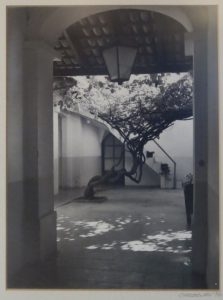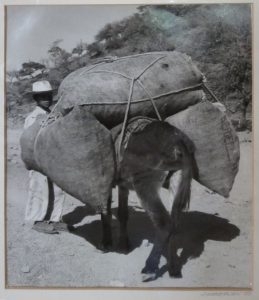Photographer and illustrator Haig Witwer Shekerjian was born 3 November 1922 in Chicago, Illinois, and finally laid his camera to rest at the age of 79 on 21 August 2002 in Schenectady, New York. He and his wife, Regina, first visited Ajijic in 1950s and became regular visitors to Ajijic thereafter.
Haig’s parents were Haig Rupen Shekerjian, a rug salesman originally from Constantinople, Turkey, who became an art lecturer at the Art Institute in Chicago, and Frances Louise Witwer, a concert pianist from Chicago. His cousins included Brigadier General Haig W. Shekerjian.
Haig attended Oak Park and River Forest Township High School in Oak Park, Illinois. His interest in photography started at an early age and, as a teenager, he was an avid member of the school’s Camera Club. After high school, he studied at the Eastman School of Photography in Rochester, New York, and at the University of New Mexico in Albuquerque. A 1943 yearbook entry shows that he was not only handsome, but also an accomplished actor, and member of the University Dramatic Club.
On leaving university, Haig joined the U.S. Navy in November 1943. In early 1944, before leaving to serve for the remainder of the second world war in the Pacific, Haig married Regina deCormier, his lifelong love.
Working as a Navy photographer, Haig Shekerjian was in the first landing party at the Battle of Iwo Jima (1945), saw action elsewhere, and photographed the Japanese surrender. He was the recipient of several military decorations. Haig’s return to the U.S. was noted in a poignant local newspaper entry in December 1945 which stated that Haig, “was one of 11,382 High Point Navy veterans returning from Guam on the U.S.S. Cowpens.”
Regina DeCormier Shekerjian (1923-2000) was a well-known author, translator and illustrator of children’s books. The couple, and their two sons (Tor and Jean-René), lived for many years in New Paltz, New York, where Haig was Art Director of the Media Services Center at the State University College for over 30 years, until the age of 75.
Taking a sabbatical break over the winter of 1950-51, Haig and Regina spent several months living in Ajijic. (Regina later published an article about why Ajijic was an excellent choice for anyone seeking an inexpensive art-related summer). They returned many times in the late 1970s, 1980s and early 1990s, often staying a few months.
Haig was apparently never very interested in the commercial aspects of photography, though his work appeared in many books, publications and literacy works, and his work was rarely exhibited or sold, though he gave away a few photographs as treasured gifts. His peers recognized the quality of his photographs and in 1977, one of his photos was included in the inaugural exhibition of the Catskill Center for Photography in Woodstock, New York.
Together with Regina, Haig Shekerjian illustrated several books, most of them written by Nancy Willard and aimed at young readers. They included The Adventures of Tom Thumb (1950); Life in the Middle Ages (1966); The boy, the rat, and the butterfly (1971); King Midas and the Golden Touch (1973); Play it in Spanish : Spanish games and folk songs for children (1973); The merry history of a Christmas pie : with a delicious description of a Christmas soup (1974); All on a May morning (1975); How Many Donkeys? A Turkish Folk Tale (1971); and The well-mannered balloon (1976).
Haig was an accomplished violinist and the Shekerjians also co-wrote, with Regina’s brother Robert deCormier, A Book of Christmas Carols (1963); and A Book of Ballads, Songs and Snatches (1965).
Michael Eager, owner of La Nueva Posada hotel in Ajijic, remembers the couple well: “Haig had short gray hair with a goatee and was rarely without his Greek sailor’s cap. Both he and Regina dressed casually, Haig with jeans, checkered shirt, and somewhat “beatnik” looking. He was never without his camera.” Both Haig and Regina loved the local people, music and traditions.

Haig Shekerjian. 1950. Ajijic Plaza.
Artist Pat Apt remembers Haig photographing Mexican families in the early 1990s, and how: “He made appointments for just after church when they would be dressed in their finest.” When Apt ran the Rabbit in the Moon Gallery in Ajijic (Ramón Corona #11, opposite the Lake Chapala Society), Haig’s work was included in a collective show, which opened 1 February 1997, alongside works by herself, Georg Rauch and Juan Navarro.
The dining room of La Nueva Posada in Ajijic has a permanent exhibition of Haig’s evocative photographs of what the Lake Chapala area was like years ago—clear evidence, if any were needed, of the couple’s immense enthusiasm for the area and its people.
Note: This post was last updated 13 August 2023.
Sources:
- Poughkeepsie Journal, Poughkeepsie, New York: 19 February 1944, p5; 23 August 2002, p 4B.
Other photographers associated with Lake Chapala:
- Ernest Alexander (ca 1916-ca 1970)
- Hugo Brehme (1882-1954)
- Horace Bristol (1908-1997)
- Frederick W. Butterlin (ca 1905-?)
- John Frost (1923-2015)
- Dorothy Hosmer (ca 1911-?)
- Ernest Walter Knee (1907-82)
- Leo Matiz (1917-1998)
- Winfield Scott (1863–1942)
- Jack Weatherington (1933-2008)
Sombrero Books welcomes comments, corrections or additional material related to any of the writers and artists featured in our series of mini-bios. Please email us or use the comments feature at the bottom of individual posts.
Tony Burton’s books include “Lake Chapala: A Postcard History” (2022), “Foreign Footprints in Ajijic” (2022), “If Walls Could Talk: Chapala’s historic buildings and their former occupants” (2020), (available in translation as “Si Las Paredes Hablaran”), “Mexican Kaleidoscope” (2016), and “Lake Chapala Through the Ages” (2008).


Thank you for this article. I love reading about my grandparents. This is lovely. I hope to learn more about them.
Thanks for the kind words. If I stumble across additional material related to your grandparents, I will update the posts about them.
Teresa Shekerjian, I knew your grandparents a little, enough to admire them. I hosted an exhibition of photos in my gallery. The local population were entranced by the photos of their older members in the 50’s. I wonder if the photos are anywhere on the internet, or if it might be possible to do a show here again.
Hi Pat, How am I only just hearing about this connection between you and the Shekerjians? Obviously I must have asked the wrong questions last time we met! Do you by any chance recall the dates you had the gallery and have any list of the shows there? Warm regards, keep well, Tony.
Dear Teresa Shekerjian,
I found this Poughkeepsie Journal article when I googled Haig Shekerjian, your grandfather, I’d read his name on the front of an old postcard that I’d purchased on eBay. The postcard photo by your grandfather was Cushing Hall, my dormitory at Vassar College in Poughkeepsie in the late ’60s. The postmark on the back was September 1943. I wondered what had brought Haig to Vassar. A young woman, very possibly. The article above revealed that his wife, Regina, was the illustrator for some of Nancy Willard’s books. The latter was a Vassar professor. Ah-ha! Their home in New Paltz could not have been far from Vassar. I’ve not yet searched the alumnae archive but am pretty certain that Regina de Cormier was a graduate, Class of 193? or 194?. Not only that, she probably lived in Cushing House as well. If I find out, I’ll let you know. All I can say for now is that I wish Haig had taken more pictures that became postcards. For all I know, his archives may include more photos of Cushing.
Thanks for your informative comment. For more about Regina, see https://lakechapalaartists.com/?p=4090 Regards, TB.